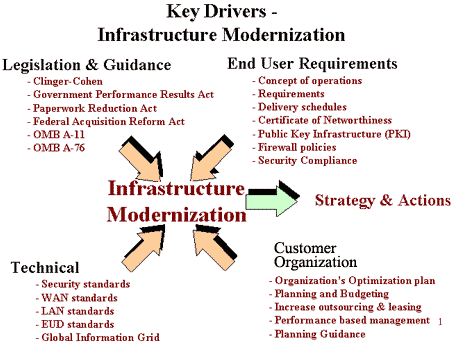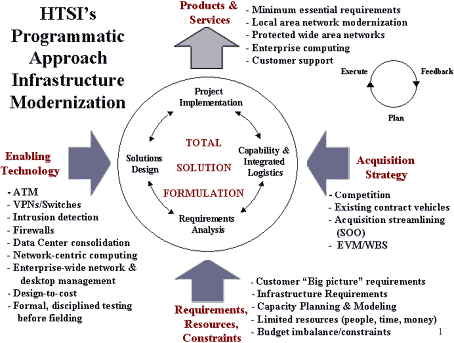
As part of implementing a total solution for its customer, HTSI wants to ensure its technology implementations are efficient and effective in helping our customers meet their needs. The figure below outlines key drivers leading an organization towards infrastructure modernization.

As such, infrastructure is an obvious issue with regard to installing a computerized patient record. HTSI refer to required upgrades to servers, LAN, LAN administration, PCs, printers, etc as infrastructure modernization. HTSI has strategically aligned itself with various leaders in the IM/IT industry to ensure the customer is provided an optimal solution. If necessary, and with customer concurrence and resourcing, HTSI or one of its partners will upgrade the LAN, acquire servers, provide LAN administration, purchase PCs, etc., as required.
After thorough analysis and as part of providing an optimal solution for its customers, HTSI will provide or sponsor infrastructure modernization services while ensuring the best value for the customer. If HTSI opts to farm out a portion of the "total solution" - it will be transparent to the customer. HTSI is committed to guaranteeing the successful implementation of the "total solution."

Typical infrastructure modernization services provided by HTSI and its partners include:
- 1. Design
- 2. Capacity Planning and Modeling
- 3. Implementation (Deployment)
- 4. Configuration Management
- 5. Operations and Maintenance (LAN Administration)
- 6. Integrated Logistics Support
As noted earlier, implementing the HTSI total solution may significantly impact the existing infrastructure within a facility, depending on the scope and depth of Electronic Medical Records, medical records coding, web library, and software application implementations. Often they require robust computing and communications infrastructure to fully realize the full features of an EMR and its desired outcome. Two critical issues are access and reliability. Because the provider/patient encounter often requires interaction from numerous locations, provider acceptance will require wireless networks and portable computers. New frontiers will also need to be addressed with regard to reliability. It is unlikely the doctors will accept any significant down time when they are dependent on on-line information at the point of service. Since providers will not have the time to redo clinical notes nor can they remember all their impressions at the time of treatment, it is very likely that any significant amount of down time will result in an unrecoverable situation with regard to having complete and accurate data. We address these issues through a gap analysis to provide the recommended changes. Infrastructure costs often neglected in formulation of EMR requirements as well as local applications (such as, email and internet browsing) support requirements. HTSI will assist in planning, budgeting, acquiring, implementing and sustaining infrastructure services to improve and maintain the implementation of the electronic medical record.
Many changes need to occur when the medical activity transitions from the traditional hospital information systems to a point of service system dependent on the provider completing an automated note. This transition requires infrastructure improvements in quality, access, responsiveness, reliability, and consistency of the infrastructure. Infrastructure includes: (1) Central computing centers; (2) Wide Area Networks (WANs); (3) Communications circuits; (4) Network protection components; (5) Local Area Networks (LANs); and (6) End User Devices (EUDs) to support standard applications.

Design provides technical support for the creation of site-specific designs, works as an active member in technical working groups, addresses the application of new technology towards forthcoming requirements, and provides assistance to efforts potentially affecting multiple facilities. Design includes the following activities:
- Using Industry security standards, determine and establish a common network architecture.
- Capitalizing on the previously defined processes for gathering, evaluating, and implementing infrastructure.
- Performing and documenting a baseline infrastructure assessment during the initial engineering site survey.
- Utilizing data collected from site surveys to develop site-specific designs and facility drawings.
- Identifying infrastructure migration planning options based on cost and schedule support constraints.
- Establishing technology insertion options to meet forthcoming requirements-driven infrastructure architecture modifications.
- Providing technical assistance into the various working groups such as Internet Protocol (IP) addressing and wide area networking for coordination purposes.

Capacity planning and modeling determines the IT infrastructure resources required to achieve agreed service levels at optimum costs. This involves the translation of user requirements or plans into a quantifiable demand for IT resources. Capacity planning and modeling can be broken down into the following sub-functions or services:
- Performance management is the capture and analysis of data from existing system(s) to ensure that optimum use is made of the hardware resources, and that agreed performance and throughput levels can be achieved and maintained.
- Workload management includes the process of identifying user workflow and characterizing its utilization of resources. In particular, an important task is to document working patterns and peaks of individual systems in terms of their resource requirements.
- Resource management is the function of taking projected workload requirements and translating them into demands for IT resources.
- Application sizing by modeling workload and resource information to forecast the IT resources required for new applications being developed, their expected performance and throughput levels, and any cost implications.
- Infrastructure sizing by modeling the workload and resource information with component technical specifications forecast solutions required for applications to meet their expected quality of service (QoS) parameters plus projected cost implications. Examples of QoS parameters include bandwidth utilization, latency, throughput, and response times.

Implementation encompasses all site preparation and infrastructure installation services for facilities. Major implementation activities include:
- Site-specific implementation and training plans
- Requirements-based site surveys
- Establishment of service level agreements, as required
- Site coordination
- Engineering design
- AutoCAD polyline drawings
- Installation Bill Of Materials (IBOM) development
- Electronic Bill Of Materials (EBOM) development
- Installation survey
- Procurement of IBOM & EBOM
- Site preparation
- Letter of Instruction (LOI) preparation
- Installation of materials
- Test plan development
- Quality assurance assistance
- Transition plan preparation
- Test and evaluation of installations
- Infrastructure transition and cut-over
- Post implementation reviews

Configuration management provides a disciplined approach to identify and document the functional and physical characteristics of a material item, controlling changes to the item characteristics, and the reporting and recording configuration information including maintenance of the infrastructure. Configuration management is composed of the following components:
- Asset Management provides an integrated asset management process to collect, maintain, and disseminate information regarding IT assets acquired as part of HTSI or a program/project. Asset management provides the ability to track the physical location and handling of infrastructure components throughout its lifecycle.
- Configuration management provides information about the functional and physical characteristics of infrastructure's hardware and software components. This information is stored and maintained in a centralized database.
- Change management manages the configuration of existing components while planning for changes to the operating environment. Together, CM and Change Management keep the Infrastructure in a documented, "known" state.

Hardware / Software Maintenance and Sparing (HSMS) provides an integrated, maintenance and sparing support operation to meet requirements for systems and infrastructure. Services include repair, maintenance, warehousing, traceable inventory control, receiving, shipping and sparing requirements for the infrastructure components/equipment (routers, power hubs, etc.) and all end-user devices (i.e., printers, Intermec equipment, Video Terminals, Keyboards, etc
|
|
|
|
 |
|

